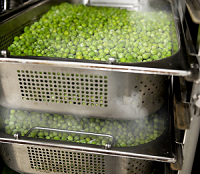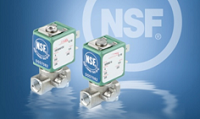Choosing Valves for New No-Lead Water System Regulations
In the U.S., regulations governing lead content of the components of potable water systems have seen considerable changes as safety restrictions tighten.
#water-wastewater #standards #components
This report outlines relevant sections of the law. It then focuses on the choices facing specifiers and purchasers who need to select important components of these systems — two-way solenoid valves — to comply. It considers the calculations that must be made to determine average lead content. Finally, it discusses the pros and cons of common valve materials (brass, composite/plastic, stainless steel and leadfree brass), as well as other selection advantages.
Looking at the Law
The U.S. Federal Reduction of Lead in Drinking Water Act was enacted on Jan. 4, 2011, to amend Section 1417 of the Safe Drinking Water Act. It took effect on Jan. 4, 2014. The Office of Water of the U.S. Environmental Protection Agency (EPA) summarized the law in a December 2013 report. In this excerpt, lead free is defined as:
A: not containing more than 0.2 percent lead when used with respect to solder and flux; and B: not more than a weighted average of 0.25 percent lead when used with respect to the wetted surfaces of pipes, pipe fittings, plumbing fittings, and fixtures.
(To ensure complete compliance, see the full document.)
Calculation
For purposes of the Act, the weighted average lead content of a pipe, pipe fitting, plumbing fitting or fixture is calculated by using the following statutory formula:
- For each wetted component, the percentage of lead in the component is multiplied by the ratio of the wetted surface area of that component to the total wetted surface area of the entire product to arrive at the weighted percentage of lead of the component.
- The weighted percentage of lead of each wetted component is added together, and the sum of these weighted percentages constitutes the weighted average lead content of the product. The lead content of the material used to produce wetted components is used to determine compliance.
- For lead content of materials that are provided as a range, the maximum content of the range must be used.
Doing the Math
This applies to all relevant equipment sold in the U.S. (except water distribution main gate valves 2 inches or more in diameter).
Thus, under the new law, “lead-free” is a cumulative concept. This does not mean that every single part of a system must meet that average. In practical terms, some parts can be over that number, some right at it and some under it. Specifiers and buyers must add up the lead content of all wetted components to get an average product percentage that must be less than or equal to 0.25% lead content.
This calculation governs the route to compliance.
How does it work in practical terms? Suppose that a manufacturer makes dishwashers. The manufacturing engineer must perform the above lead content calculation, averaging all of a given model’s relevant components: stainless-steel wash tank, copper piping, brass solenoid valves and so on.
In this example, the calculation would show that the manufacturer need make no design changes to comply with the new, lower lead content law. The engineer can keep using his or her favorite brass valve. True, the brass is stated to have 2.5% lead content — well over the 0.25% limit. But that limit is for all relevant parts of the dishwasher. Fortunately, the relatively small wetted surface area of the valve is outweighed by the large wetted surface of the stainless-steel tank, with zero lead content. So the dishwasher remains in compliance.
Thus in many cases, manufacturers and contractors won’t need to change any preference for a particular valve type. In some other cases, compliance might dictate another valve. Water equipment makers must query the manufacturers of their valves and other components to ascertain the precise internal wetted areas of parts, and the lead content of each part. A qualified manufacturer will be happy to furnish such information.
With this information in hand, the calculation should be a relatively straightforward matter. It’s important to perform it for every piece of water system equipment. Though this is a federal law, compliance will be enforced by state and municipal building and health inspectors.
Aside from the compliance issue, it’s also important to select valves with the ratings for pipe size, pressure, flow and so on as required by the application as well as appropriate agency approvals.
Finally, in cases where the calculation is close, remember that with solenoid valves, selecting different materials of construction can help achieve compliance.
Selecting Brass
The traditional choice of solenoid valve material for many OEMs and contractors, brass possesses well known characteristics and typically requires no changes to the existing system or equipment. It’s also considered a good value.
However, brass components often contain about 2.5% lead content. This can tip the balance in calculations of total lead content for a given product. If so, using brass valves will not comply with the new law. Manufacturers and contractors working with brass valves must perform the calculation specified above to be sure.
Selecting Composite/Plastic
Solenoid valves constructed of composites or plastics start with the advantage of 100% lead-free construction.
They’re also available in numerous pipe sizes and configurations, including those common to drinking water equipment. These valves are a popular choice for residential/commercial drinking water service. Their completely lead-free construction may help an entire product qualify as compliant under a total wetted areas calculation.
Composites may be slightly more expensive than brass valves. In retrofits on established systems, they may also require some adjustment of engineering drawings, differing in facetoface dimensions from their brass counterparts.
Composite valves exhibit various maximum pressures that can go up to 150 pounds. As with any new valve selection, it’s important to make sure they perform with the necessary reliability and carry the proper ratings and characteristics for the application.
Selecting Stainless Steel
These models are usually easily interchangeable with legacy brass valves; figuring in their lead-free content may help qualify an entire product.
However, stainless steel is typically the most expensive material of construction used in water system solenoid valves.
Selecting Lead-Free Brass
Not yet widely offered, solenoid valves in lead-free brass are currently in late stages of development at several valve manufacturers. Specifiers and purchasers should expect a wider selection of these valves by late 2014 or 2015.
Their chief advantage is that they are lead-free in a traditional metal body. Naturally, they should provide complete interchangeability with legacy brass valves. As with any model where users are changing to valves of a different material, care should be taken to test reliability and make sure of proper ratings for each given application.
Other Selection Advantages
Certification
Third-party certification by a standards entity such as NSF International is desirable or mandated for components of many water systems. Going beyond a manufacturer’s mere statement of compliance, it offers independent, accredited validation from a trusted source.
In particular, NSF-approved valves are almost always the choice of manufacturers whose systems or assemblies as a whole carry NSF approvals. For example, local codes often demand that reverse osmosis (RO) systems bear this certification. These manufacturers may thus choose NSF-approved valves exclusively, not wishing to spend time or budget seeking separate NSF approval for a new valve alone.
Fasteners
Solenoid valve fastener technology is often of particular interest to contractors installing or maintaining water systems. They prioritize features that save time, trouble and cost on the jobsite.
Availability
Lastly, water system OEMs and contractors with demanding assembly or replacement schedules may weigh ordering, shipping and delivery times during valve selection. No one likes to hold up an entire project or keep a system shutdown waiting for a few valves. Some valve manufacturers may present built-in delivery disadvantages for North American customers, because these suppliers make their valves in Europe.
Where this poses a potential problem, specifiers and purchasers should consider North American manufacturers with quickshipment programs.
Conclusion
Calculations to meet new water system lead-free content laws are straightforward, once each maker supplies the necessary information for each component. Valves and other parts can then be selected according to cost, reliability, ratings and approvals that the application demands. OEMs and contractors have plenty of choices to ensure their potable water systems meet all requirements for full compliance.
Anne-Sophie Kedad-Chambareau is product marketing manager, ASCO Numatics, an Emerson company. Contact her at info-valve@asco.com.
RELATED CONTENT
-
The Next Step in Functional Safety
The primary goal of functional safety is to prevent accidents.
-
Understanding and Selecting Valve Flanges, Pt. I: Design and Standards
Because flanges allow the assembly and maintenance of system components without the need for cutting and welding pipe, they play an important role in piping systems.
-
The Valve Industry Finds Value in ESG Initiatives
The valve manufacturing industry in North America is one of the industries that have embraced this new way of thinking and is leading the way with the integration of environmental, social, and governance (ESG) initiatives. These initiatives range from valves designed to mitigate climate change to community involvement activities.













 Unloading large gate valve.jpg;maxWidth=214)